Evolution has crafted some amazing design solutions to the problems of life, and I never have enough of their elegance.
Take the crocodile’s heart.

Crocodiles have a special bypass short circuiting blood flow to their lungs. Specifically, although they have the same four chambered heart configuration as us mammals, which pumps the blood first to the lungs to get oxygenated and then to the body to use that Oxygen, they have a special hole – the Foramen of Panizza – that connects the blood vessels leaving the heart’s two ventricles so that blood can flow from one circuit to the other without visiting the lungs. What’s more – and this is the cool part – in some species, a special valve enables the short circuit only during prolonged diving, when the lungs are useless anyway.
Is that cool, or what?!
Was in Germany and saw these in a supermarket. The thing is called Bischofsmütze – which means Bishop’s hat, although there’s something vaguely oriental (Islamic oriental, I mean) about it.

This is the weirdest fruit I remember ever running into – it looks like it’s a mashup of two different species, with the poor attention to finish seen in Frankenstein’s monster…
My first reaction was, that settles the heated controversy: surely no intelligent design can be seen in this ridiculous fruit! But then I had to admit: even the most meticulous designer may express a sense of humor now and then… 🙂
You may have heard of the Aquatic Ape theory, which deduces from our hairless skin that our ancestors had gone through an ocean-dwelling phase. Well — here is my new theory: that the common cat, Felis catus, evolved from a flying creature!
Consider the cat’s ear. Whenever I scratch a cat behind the ears I can’t help but notice the way the external ear is split near its base, forming a narrow hollow. This seemingly useless feature always reminds me of the wing root air intake seen on some jet fighters, like the Hawker Hunter seen in the photo.
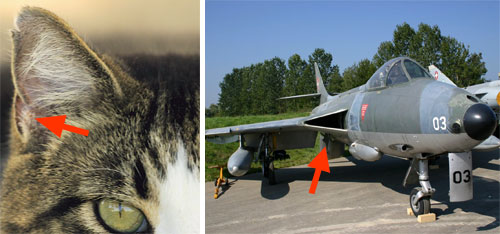
So why would the cat have this vestigial structure? Obviously, because in some earlier part of its evolution it was a flying creature, using flight to catch small birds in midair, which remain a favorite source of food with modern cats as well. Then some proto-cat discovered that it’s far easier to charm the evolving human race into feeding it, and the wings were lost over the generations, becoming the ears we see today.
Oh well, not really…
[Photo credits: Hawker hunter by Arnauld Gaillard. Cat by Michael Seljos].
While taking in the wonderful Israel Perosnal Computer Museum in Haifa I came face to face with the Intelligent Systems Compucolor II, a bizarre 1977 home computer built into a repurposed 13″ TV set.

What drew my attention was the strange keboard layout: the arrow keys were clustered at the top right corner. This is in contrast to what you will see on every keyboard in the present century, where these keys are invariably at the bottom right of the keyboard.
 So, here we see a layout that has disappeared without any living descendants: an extinct primordial denizen of the keyboard universe. And for good reason: the standard location puts the arrows nearest the user, where the CompuColor II had them farthest away. It’s bad enough that the mechanical issues of old typewriters forced on us the QWERTY layout, with the most used keys out on the top letter row; since those typewriters did not have arrow keys, there is no reason to apply the same counter-ergonomic approach to them too!
So, here we see a layout that has disappeared without any living descendants: an extinct primordial denizen of the keyboard universe. And for good reason: the standard location puts the arrows nearest the user, where the CompuColor II had them farthest away. It’s bad enough that the mechanical issues of old typewriters forced on us the QWERTY layout, with the most used keys out on the top letter row; since those typewriters did not have arrow keys, there is no reason to apply the same counter-ergonomic approach to them too!
It is interesting to note that unlike today’s notebooks, where space is at a premium, the keyboard in these photos has lots of free space around it, and is no doubt made of individual switches; so there was no reason to put the arrows in this awkward position. Someone just hadn’t thought it through. And of course those were early years for home computing, with each manufacturer trying their own ideas, resulting in an Ediacaran Fauna of weird form factors (remember the venerable Commodore 64, whith only two arrow keys that you SHIFTed to move in the remaining directions?). Small wonder, then, that most of these experiments – like this one – left no trace except as museum fossils!
The intense pressure of natural selection has given us many magnificent examples of optimized design in nature. Here is a lovely case: the dentition of Heterodontus Portusjacksoni, the Port Jackson shark. I saw these jaws at a nature museum and just had to snap a photo…
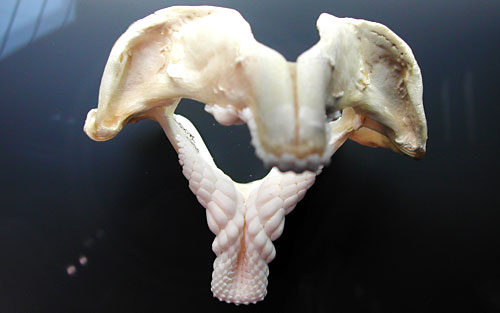
This shark has unusual teeth – none of the flesh-ripping daggers that the “Jaws” movie brought to fame (while giving sharks a bad name that may help drive them to extinction). It feeds on mollusks, and uses the tiny spiked teeth in front to grab them and the blunt ones in the back to crush them.
But what I found most appealing is the geometrical structure of the entire set, which has a mathematical elegance and hints at a similarly elegant growth mechanism. One can imagine that the whole complexity of these teeth is generated in one continuous process governed by a very simple equation. Just like a fractal…
Math and nature and beauty, all in one chunk of bone! 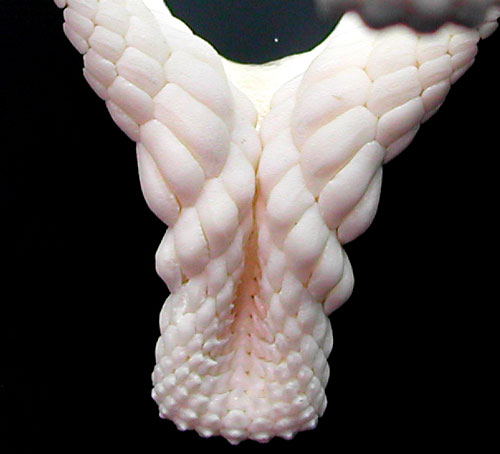
Children in Oregon can enjoy giant redwood forests… but here in the holy land a semi-arid climate and millennia of human abuse force us to make do with less. Still, the humble grasses, weeds, wildflowers and thorny shrubs that we do have make an exuberant comeback every spring; and they remind me of an unforgettable nature study assignment given us by my elementary school teacher long ago.
The idea was simple: we had to collect as many different fruits of wild plants as we could find. These we had to pack in small cellophane sachets and bring them to class. Sounded trivial… until, a few weeks later, I had close to 100 different specimens, enough to fill a shoebox (the universal storage solution in those pre-Ikea days). That box is long gone, but I stopped at a nearby field and shot two photos of species that must’ve been in it back then.


In addition to the obvious fun of having to hunt through the fields, we learned two lessons: that there is a huge diversity of plant life (after all, we filled our boxes within walking distance of our homes); and that plants were fascinating! We were afforded a first hand look into nature’s manifold ingenious ways to solve the problem of seed dispersal; you can bet we also took the time to open the fruits and see how they worked…
In case you doubt this is interesting, here is a section through the fruit of the unremarkable-looking plant in the left photo. See the burrs that attach to passing animals (or kids!); the skin that is designed to break open when dry; and the seeds that would spill out at that time. Fascinating – yes, even for an adult!…
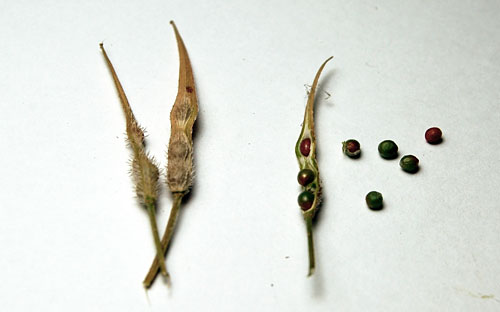
And now, a tip of the hat to a nifty solution to the oldest design problem of them all: how do you spread your genes?
I was taking a shortcut through an overgrown field and ended up with a load of seeds stuck to my socks and shoelaces. When I sat down to pluck them out, I found there were two models: the smaller (some 5 mm long) “fuzzy” seeds (right in the photo) actually had many tiny thorns that did the job; but the larger seeds (up to 9 mm in length) were really impressive, each sporting long, needle-sharp spines all over. I wish I had a good stereo microscope to give you better detail, but you can get the idea from the photos below.
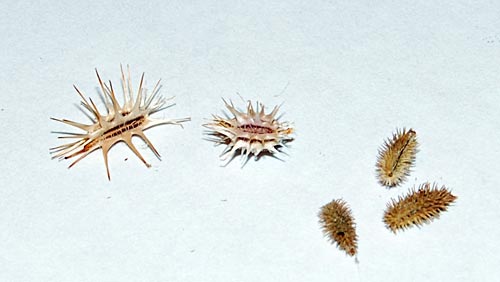
So what? So nothing, I guess, except that being an engineer I had to stop and admire the effectiveness of these designs.
And here is another look:

Makes you feel kinda special, to think that these plants would go to all this trouble to evolve seeds that stick like leeches to your socks! 🙂
In times of old, intrepid European explorers who ventured into remote countries like China or Africa would return with travelers’ tales of amazing creatures such as have never been seen. And apparently such wonderful animals still exist in far away lands, reflected in the meager evidence that filters back. Take this sighting…
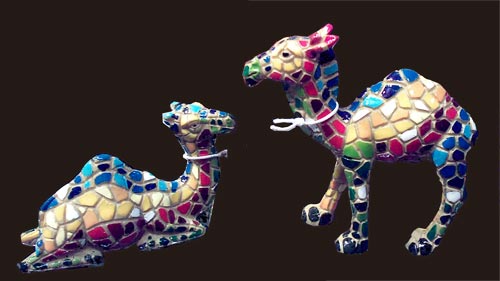
I saw these small figurines – and dozens like them – on display at a souvenir shop in Ben Gurion International Airport. Nothing surprising about camel figurines in an Israeli tourist trap, after all we do have camels in this country, though you’d need to travel far into the desert to find any. The price tags said these were made in China – no surprise there either, everything is these days.
There were two models: a kneeling animal, with the unmistakable hump, thin legs,and small-eared head of a camel; and a standing one, with the hump of a camel, and the short thick legs, long ears, and stiff mane of a… donkey. Indeed, other than the hump, the Chinese craftsman has done an excellent job of capturing the anatomy of this patient beast of burden. The travelers were right: wondrous chimeric beasts must exist in China, and they seem to inspire Chinese product design!
Here is a skull that used to belong to a smallish plant-eating dinosaur, and as he doesn’t need it any more, it is on display at the Museum für Naturkunde in Berlin.
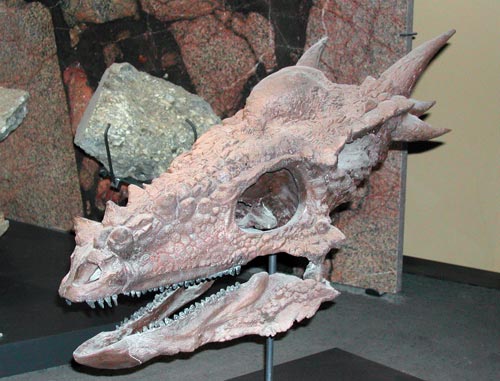
When I saw this exhibit, I couldn’t avoid a flash of recognition: this guy looks just like the devil! It isn’t just the horns, or the reddish tint… it’s the whole countenance of the beast, the evil toothy grin, the scaly look, that je ne sais quoi that has become part of the prince of hell’s iconic look in Western culture.
And indeed, the similarity hasn’t been lost on its discoverers who named this beauty Stygimoloch Spinifer – “horned devil from the Styx”.
Here is another view of the same specimen:

One ugly devil of a dinosaur, if you ask me…
The idea of a time traveler messing up the present by changing the past is a Sci-Fi staple, and is used to good advantage in Ray Bradbury’s 1952 short story, “A sound of thunder”. Bradbury’s subtlety is sadly lost in the 2005 movie of the same name; here, silly looking monsters run amok in the perturbed present of the movie. If you haven’t watched it, you may wish to save your time for something better.
However, there is one monster that caught my attention. This is a 50-foot eel-like monster that happily chases the humans in the flooded subway tunnels. here are two shots of its head:
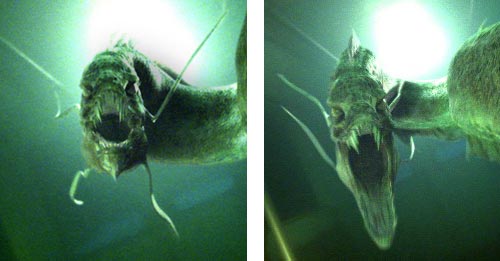
These photos don’t do the eel justice -this is one creature you don’t want to be close to – but what struck my associative imagination at once was the certainty that I’ve seen this face before!
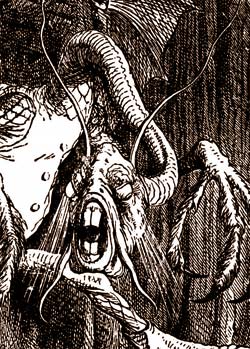 You can see where I’d met it in the image at right. This is a detail from John Tenniel’s illustration of the Jabberwock, the monster in Lewis Carroll’s immortal nonsense poem from the second Alice book, “Through the looking glass”. Here is the very same bulbous head on a long neck, with the four tentacles and the bulging eyes. Only the dentition is different.
You can see where I’d met it in the image at right. This is a detail from John Tenniel’s illustration of the Jabberwock, the monster in Lewis Carroll’s immortal nonsense poem from the second Alice book, “Through the looking glass”. Here is the very same bulbous head on a long neck, with the four tentacles and the bulging eyes. Only the dentition is different.
So how did the Jabberwock and the Eel come to be so similar? I see two possibilities. Perhaps the movie’s effects people had seen the Tenniel classic and copied it, consciously or otherwise. But if they haven’t, we may have here a strange case of convergent evolution, where two unrelated creatures evolve in parallel under similar constraints and attain the same outcome. What parallel constraints, you ask? Well, in both cases the artists were striving to objectify nonsense. Carroll’s Jabberwock is part of a wonderful nonsense poem; whereas the movie, though far from wonderful, is itself a sorry piece of cinematic nonsense!




 So, here we see a layout that has disappeared without any living descendants: an extinct primordial denizen of the keyboard universe. And for good reason: the standard location puts the arrows nearest the user, where the CompuColor II had them farthest away. It’s bad enough that the mechanical issues of old typewriters forced on us the QWERTY layout, with the most used keys out on the top letter row; since those typewriters did not have arrow keys, there is no reason to apply the same counter-ergonomic approach to them too!
So, here we see a layout that has disappeared without any living descendants: an extinct primordial denizen of the keyboard universe. And for good reason: the standard location puts the arrows nearest the user, where the CompuColor II had them farthest away. It’s bad enough that the mechanical issues of old typewriters forced on us the QWERTY layout, with the most used keys out on the top letter row; since those typewriters did not have arrow keys, there is no reason to apply the same counter-ergonomic approach to them too!










 You can see where I’d met it in the image at right. This is a detail from John Tenniel’s illustration of the
You can see where I’d met it in the image at right. This is a detail from John Tenniel’s illustration of the 
